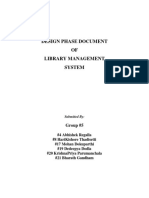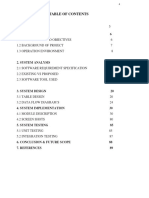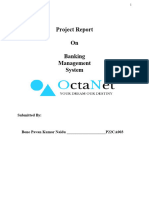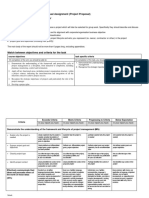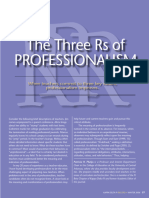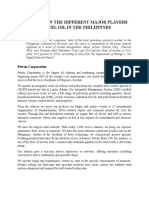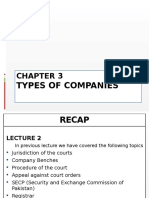LIBRARY MANAGEMENT SYSTEM SOFTWARE REQUIREMENT SPECIFICATION
1
� LIBRARY MANAGEMENT SYSTEM SOFTWARE REQUIREMENT SPECIFICATION
SOFTWARE REQUIREMENT SPECIFICATION(SRS)
1. CATEGORY :
I want to build online library management system website as web based library management
system would be ideal for all the member who can access the system in internet .An app, or
software application, isn't directly accessible on the internet. Rather, it must be downloaded
on a smartphone or tablet ,so I want to build this system as website.
2. PURPOSE :
The Online Library Management has been designed to computerize and automate the
operations performed over the information about the members, book issues and
returns and all other operations.
This computerization of library helps in many instances of its maintenances.
It reduces the workload of management as most of the manual work done is reduced.
Provided the college and the students a well-organize and well-presented reports.
All the user of library can easily login in the website.
Students can search the books easily in the website.
Students can easily borrow book without spending so much time.
Ebook facility will be available for all the user.
2
� LIBRARY MANAGEMENT SYSTEM SOFTWARE REQUIREMENT SPECIFICATION
3.SCOPE:
The Online Library Management System is supposed to have the following features.
The system provides login facility to the users.
The product provides the members with online booking of books capabilities and the
Online Library System is up and running all day.
The system allows the members to search the books they want to borrow .
The book catalogue is automated and the decision of offering the book based on the
category of the book is automatically decided.
Student can select the book they wanted to renew.
The system updates the book information as and when the member returns a book.
If a book is issued by someone then the user can reserve it , so that later the user can
issue it.
The fine will be calculated, if it crossed the date of return and the user did not
renewed if then fine will be applied by Rs 10 per day.
Librarian can add books in the website.
Librarian can remove any books if he wants.
4. INTRODUCTION
Traditionally, library systems are used manually. Forms are given to the Librarian and they
fill them of using pens. The manual library system is very time consuming and a tiresome
task. The primary complaint of some Librarians with this manual system is the tiresome task
of searching records. The fast changed of technology describe a lot to the development of the
library system. The online library management system may help all to manage the task of
library.
3
� LIBRARY MANAGEMENT SYSTEM SOFTWARE REQUIREMENT SPECIFICATION
4)a. EXISTING PROCESS:
Early days Libraries are managed manually. It required lot of time to record or to
retrieve the details. The employees who have to record the details must perform their
job very carefully. Even a small mistake would create a lot of problems. Security of
information is very less. Report generations of all the information is very tough task.
Maintenance of Library catalogue and arrangement of the books to the catalogue is
very complex task. In addition to its maintenance of member details, issue dates and
return dates etc. manually is a complex task.
All the operations must be performed in perfect manner for the maintenance of the
library with out any degradation which may finally result in the failure of the entire
system.
4)b. PROPOSED APPLICATION:
To solve the inconveniences as mentioned in the existing system, an Online Library
Management System is proposed. The proposed system contains the following features:
The students will register them through Online
Individually each member will have his account through which they can access the
information they needs.
Book details like authors, number of copies totally maintained by library, present
available number of books, reference books, non-reference books etc. all this
information can be made handy.
Regarding the members designation, number of books was issued.Issue dates and
returns of each member is maintained separately and fine charged if there is any delay
in returning the book.
Administrator can add, update the books.
Time consuming is low, gives accurate results, reliability can be improved with the
help of security.
4
� LIBRARY MANAGEMENT SYSTEM SOFTWARE REQUIREMENT SPECIFICATION
5. ADVANTAGES:
Improvement in control and performance
The system is developed to cope up with the current issues and problems of
library .The system can add user, validate user and is also bug free.
Save cost
After computerized system is implemented less human force will be required to
maintain the library thus reducing the overall cost.
Save time
Librarian is able to search record by using few clicks of mouse and few search
keywords thus saving his valuable time.
Option of online Notice board
Librarian will be able to provide a detailed description of workshops going in the
college as well as in nearby colleges
Lecture Notes
Teacher have a facility to upload lectures notes in a pdf file having size not more than
10mb
5
� LIBRARY MANAGEMENT SYSTEM SOFTWARE REQUIREMENT SPECIFICATION
6. FUNCTIONAL REQUIREMENTS
REGISTER
Description : First the user will have to register/sign up. There are two different
type of users.
The library manager/head : The manager have to provide details about
the name of library,address, phone number, email id.
Regular person/student : The user have to provide details about
his/her name of address,phone number, email id.
SIGN UP
Input: Detail about the user as mentioned in the description.
Output: Confirmation of registration status and a membership number and
password will be generated and mailed to the user.
Processing: All details will be checked and if any error are found then an error
message is displayed else a membership number and password will be generated.
LOGIN
Input: Enter the membership number and password provided.
Output : User will be able to use the features of website.
MANAGE BOOKS BY USER.
6
� LIBRARY MANAGEMENT SYSTEM SOFTWARE REQUIREMENT SPECIFICATION
BOOKS ISSUED.
Description: List of books will be displayed along with the date of return.
SEARCH
Input : Enter the name of author's name of the books to be issued.
Output : List of books related to the keyword.
ISSUES BOOK
State : Searched the book user wants to issues.
Input : click the book user wants.
Output : confirmation for book issue and apology for failure in issue.
Processing : if selected book is available then book will be issued else error
will be displayed.
RENEW BOOK
State : Book is issued and is about to reach the date of return.
Input : Select the book to be renewed.
Output : confirmation message.
Processing : If the issued book is already reserved by another user then error
message will be sent and if not then confirmation message will be displayed.
RETURN
Input : Return the book to the library.
Output : The issued list will be updated and the returned book will be listed
out.
RESERVE BOOK
Input : Enter the details of the book.
Output : Book successfully reserved.
Description : If a book is issued by someone then the user can reserve
it ,so that later the user can issue it.
FINE
Input : check for the fines.
Output : Details about fines on different books issued by the user.
Processing : The fine will be calculated, if it crossed the date of return and the
user did not renewed if then fine will be applied by Rs 10 per day
7
� LIBRARY MANAGEMENT SYSTEM SOFTWARE REQUIREMENT SPECIFICATION
MANAGE BOOKS BY LIBRARIAN
Update details of books
Add books
Input : Enter the details of the books such as names ,author ,edition, quantity.
Output : confirmation of addition.
Remove books
Input : Enter the name of the book and quantity of books.
Output : Update the list of the books available
7.NON FUNCTIONAL REQUIREMENTS
PERFORMANCE REQUIREMENTS
This software is not breakdown suddenly in any disaster like power failure.
The development of the software will be based on the object oriented model.
The timeline of this software must be in our mind.
The performance of the functions and every module must be well.
At every step the output of the one phase is the input of the other phase and it
will be reliable and accurate.
The risk factor must be taken at initial step for better performance of the
software.
For individual function the performance will be well.
For login to the software password and user name will be matched to the
password and name
saved in the database and thus only authenticated users are allowed to the
login.
There will be various ways of retrieving data and it takes less time.
There will be ambiguity in the data and the record.
This software will be well supported to the other embedded software such as
digital dairy, notepad etc.
8
� LIBRARY MANAGEMENT SYSTEM SOFTWARE REQUIREMENT SPECIFICATION
The overall performance of the software will reliable and enable the users to
work efficiently.
SECURITY REQUIREMENTS
There will be proper security regarding to the accessing of data.
The external security can be provided by given the login authentication.
The data that are stored in the database must be private.
There is also required a user authentication.
There is also the facility that the admin can lock his private data that will not
be accessed by anyone.
The whole software is secure from the outside accessing.
SOFTWARE QUALITY ATTRIBUTES
Our software has many quality attribute that are given below-
Adaptability- This software is adaptable by any organization.
Availability - The availability of the software is easy and for everyone.
Correctness- The results of the function are pure and accurate.
Flexibility- The operation may be flexible and reports can be presented in many
ways.
Maintainability- After the deployment of the project if any error occurs then it can be
easily maintain by the software developer.
Portability-The software can be deployed at any machine.
Reliability-The performance of the software is better which will increase the
reliability of the software.
Reusability-The data and record that are saved in the database can be reused if
needed.
Robustness-If there is any error in any window or module then it does not effect the
remaining part of the software.
9
� LIBRARY MANAGEMENT SYSTEM SOFTWARE REQUIREMENT SPECIFICATION
Testability-The software will be tested at every.
Alpha Testing
Beta Testing
Acceptance Testing
Usability-To performs any operations and to understand the functioning of software
is very easy.
Productivity-This software will produce every desired result with accurately.
Timelines-The time limit is very important. It will save much time and provide fast
accessing.
Cost effective-This software is less in cost and bearable by any organization.
8.SOFTWARE TOOLS
The whole Project is divided in two parts the front end and the back end.
FRONT END :The front end is designed using of html css, Java script.
HTML- HTML or Hyper Text Markup Language is the main mark up language for
creating web pages and other information that can be displayed in a web
browser.HTML is written in the form of HTML elements consisting of tags enclosed
in angle brackets (like <html>),within the web page content. HTML tags most
commonly come in pairs like <h1>and<h1> although some tags represent empty
elements and so are unpaired, for example <img>. The first tag in a pair is the start
tag, and the second tag is the end tag (they are also called opening tags and closing
tags). In between these tags web designers can add text, further tags, comments and
other types of text-based content. The purpose of a web browser is to read HTML
documents and compose them into visible or audible web pages. The browser does
not display the HTML tags, but uses the tags to interpret the content of the
page.HTML elements form the building blocks of all websites. HTML allows images
and objects to be embedded and can be used to create interactive forms. It provides a
means to create structured documents by denoting structural semantics for text such as
10
� LIBRARY MANAGEMENT SYSTEM SOFTWARE REQUIREMENT SPECIFICATION
headings, paragraphs, lists, links, quotes and other items. It can embed scripts written
in languages such as JavaScript which affect the behaviour of HTML web pages.
CSS- Cascading Style Sheets(CSS) is a style sheet language used for describing the
look and formatting of a document written in a markup language. While most often
used to style web pages and interfaces written in HTML and XHTML, the language
can be applied to any kind of XML document, including plain XML, SVG and XUL.
CSS is a cornerstone specification of the web and almost all web pages use CSS style
sheets to describe their presentation.CSS is designed primarily to enable the
separation of document content from document presentation, including elements such
as the layout, colours, and fonts. This separation can improve content accessibility,
provide more flexibility and control in the specification. of presentation
characteristics, enable multiple pages to share formatting, and reduce complexity and
repetition in the structural content (such as by allowing for table less web design).CSS
can also allow the same markup page to be presented in different styles for different
rendering methods, such as on-screen, in print, by voice (when 14 read out by a
speech-based browser or screen reader) and on Braille-based, tactile devices. It can
also be used to allow the web page to display differently depending on the screen size
or device on which it is being viewed. While the author of a document typically links
that document to a CSS file, readers can use a different style sheet, perhaps one on
their own computer, to override the one the author has specified. However if the
author or the reader did not link the document to a specific style sheet the default style
of the browser will be applied.CSS specifies a priority scheme to determine which
style rules apply if more than one rule matches against a particular element. In this so-
called cascade, priorities or weights are calculated and assigned to rules, so that the
results are predictable.
JAVA SCRIPT- JavaScript(JS) is a dynamic computer programming language. It
is most commonly used as part of web browsers, whose implementations allow client
side scripts to interact with the user, control the browser, communicate
asynchronously, and alter the document content that is displayed. It is also being used
11
� LIBRARY MANAGEMENT SYSTEM SOFTWARE REQUIREMENT SPECIFICATION
in server-side programming, game development and the creation of desktop and
mobile applications. JavaScript is a prototype-based scripting language with dynamic
typing and has first-class functions. Its syntax was influenced by C. JavaScript copies
many names and naming conventions from Java, but the two languages are otherwise
unrelated and have very different semantics. The key design principles within
JavaScript are taken from the Self and Scheme programming languages. It is a
multiparadigm language, supporting object-oriented, imperative, and functional
programming styles. The application of JavaScript to use outside of web pages—for
example, in PDF documents, site-specific browsers, and desktop widgets—is also
significant. Newer and faster JavaScript VMs and platforms built upon them (notably
Node.js) have also increased the popularity of JavaScript for server-side web
applications. On the client side, JavaScript was traditionally implemented as an
interpreted language but just-in-time compilation is now performed by recent (post-
2012) browsers.
BACKEND: PHP is used for backend.
PHP- PHPis a server-side scripting language designed for web development but also
used as a general-purpose programming language. PHP is now installed on more than
244 million websites and 2.1 million web servers. Originally created by 15 Rasmus
Lerdorf in 1995, the reference implementation of PHP is now produced by The PHP
Group. While PHP originally stood for Personal Home Page, it now stands for PHP:
Hyper text Preprocessor, a recursive backronym.PHP code is interpreted by a
webserver with a PHP processor module, which generates the resulting web page:
PHP commands can be embedded directly into an HTML source document rather than
calling an external file to process data. It has also evolved to include a command-line
interface capability and can be used in standalone graphical applications. PHP is free
software released under the PHP License. PHP can be deployed on most web servers
and also as a standalone shell on almost every operating system and platform, free of
charge.
DATABASE: MySQL is used for database.
MYSQL- MySQL("My S-Q-L", officially, but also called "My Sequel") is (as
ofJuly 2013) the world's second most widely used open-source relational database
12
� LIBRARY MANAGEMENT SYSTEM SOFTWARE REQUIREMENT SPECIFICATION
management system (RDBMS). It is named after co-founder Michael Widenius
daughter, My. The SQL phrase stands for Structured Query Language. The MySQL
development project has made its source code available under the terms of the GNU
General Public License, as well as under a variety of proprietary agreements. MySQL
was owned and sponsored by a single for-profit firm, the Swedish company MySQL
AB, now owned by Oracle Corporation .MySQL is a popular choice of database for
use in web applications, and is a central component of the widely used LAMP open
source web application software stack (and other 'AMP' stacks). LAMP is an acronym
for "Linux, Apache, MySQL, Perl/PHP/Python." Free-software-open source projects
that require a full-featured database management system often use MySQL. For
commercial use, several paid editions are available, and offer additional functionality.
Applications which use MySQL databases include: TYPO3, MODx, Joomla,
WordPress, phpBB, MyBB, Drupal and other software. MySQL is also used in many
high-profile, large-scale websites, including Wikipedia, Google (though not for
searches), Facebook, Twitter, Flickr, and YouTube.
IDE: Visual Studio code is used as an ide for this project.
9.DEPLOYMENT:
Software specification
Operating system: Windows 10 operating system needs to be installed in
client machine.
Database: MYSQL needs to be installed in client machine for Databse
management.
Hardware specification
Processor: Minimum Intel core i3 processor is required in client machine for
smooth functioning.
Ram: Minimum 2gb ram is required for better Performance.
Hard disk: 20 gb hard disk required for database usage in future.
13
� LIBRARY MANAGEMENT SYSTEM SOFTWARE REQUIREMENT SPECIFICATION
10.HARDWARE TOOLS:
Processor: Intel core i5 8th generation is used as a processor because it is
faster than other processors and provide reliable and stable and we can run our
pc for long time. By using this processor we can keep on developing our
project without any worries.
Ram: Ram 4 gb is used as it will provide fast reading and writing capabilities
and will in turn support in processing.
Hard disk: 100 gb hard disk is used for better memory management.
11.GANTT CHART:
14
� LIBRARY MANAGEMENT SYSTEM SOFTWARE REQUIREMENT SPECIFICATION
12.COST ESTIMATION:
COCOMO MODEL: Cocomo (Constructive Cost Model) is a regression model based on
LOC, i.e., number of Lines of Code. It is a procedural cost estimate model for software
projects and is often used as a process of reliably predicting the various parameters
associated with making a project such as size, effort, cost, time, and quality. It was proposed
by Barry Boehm in 1981 and is based on the study of 63 projects, which makes it one of the
best-documented models.
The key parameters which define the quality of any software products, which are also an
outcome of the Cocomo are primarily Effort & Schedule:
• Effort: Amount of labour that will be required to complete a task. It is measured in person-
months units.
• Schedule: Simply means the amount of time required for the completion of the job, which
is, of course, proportional to the effort put in. It is measured in the units of time such as
weeks, months.
Different models of Cocomo have been proposed to predict the cost estimation at different
levels, based on the amount of accuracy and correctness required. All of these models can be
applied to a variety of projects, whose characteristics determine the value of constant to be
used in subsequent calculations. These characteristics pertaining to different system types are
mentioned below.
Boehm’s definition of organic, semidetached, and embedded systems:
• Organic – A software project is said to be an organic type if the team size required is
adequately small, the problem is well understood and has been solved in the past and also the
team members have a nominal experience regarding the problem.
• Semi-detached – A software project is said to be a Semi-detached type if the vital
characteristics such as team size, experience, knowledge of the various programming
environment lie in between that of organic and Embedded. The projects classified as Semi-
Detached are comparatively less familiar and difficult to develop compared to the organic
ones and require more experience and better guidance and creativity. Eg: Compilers or
different Embedded Systems can be considered of Semi-Detached type.
• Embedded – A software project requiring the highest level of complexity, creativity, and
experience requirement fall under this category. Such software requires a larger team size
than the other two models and also the developers need to be sufficiently experienced and
creative to develop such complex models.
15
� LIBRARY MANAGEMENT SYSTEM SOFTWARE REQUIREMENT SPECIFICATION
TYPES OF MODELS: COCOMO consists of a hierarchy of three increasingly detailed and
accurate forms. Any of the three forms can be adopted according to our requirements. These
are types of COCOMO model:
• Basic COCOMO Model
• Intermediate COCOMO Model
• Detailed COCOMO Model
CALCULATING COST, EFFORT & DEVELOPMENT TIME:
For Cost Estimation, we are using Basic COCOMO Model as we are concern about Effort and
Development time and because Basic model is very accurate in calculating these two factors so it will
be beneficial to use this model.
From the basic COCOMO estimation formula for organic software:
Effort = 2.4 х (KLOC)^1.05 PM
Development time = 2.5 х (Effort)^0.38 M
Cost required to develop the product = Effort x Salary per month
Assume,
Line of code=4000=4kloc
Salary per month=20000 Rs.
Now,
Effort = 2.4 х (4)^1.05 PM
=10 PM
Development time = 2.5 х (10)^0.38 M
=6 M
Cost required to develop the product =10 x 20000 Rs.
=200000 Rs.
16




